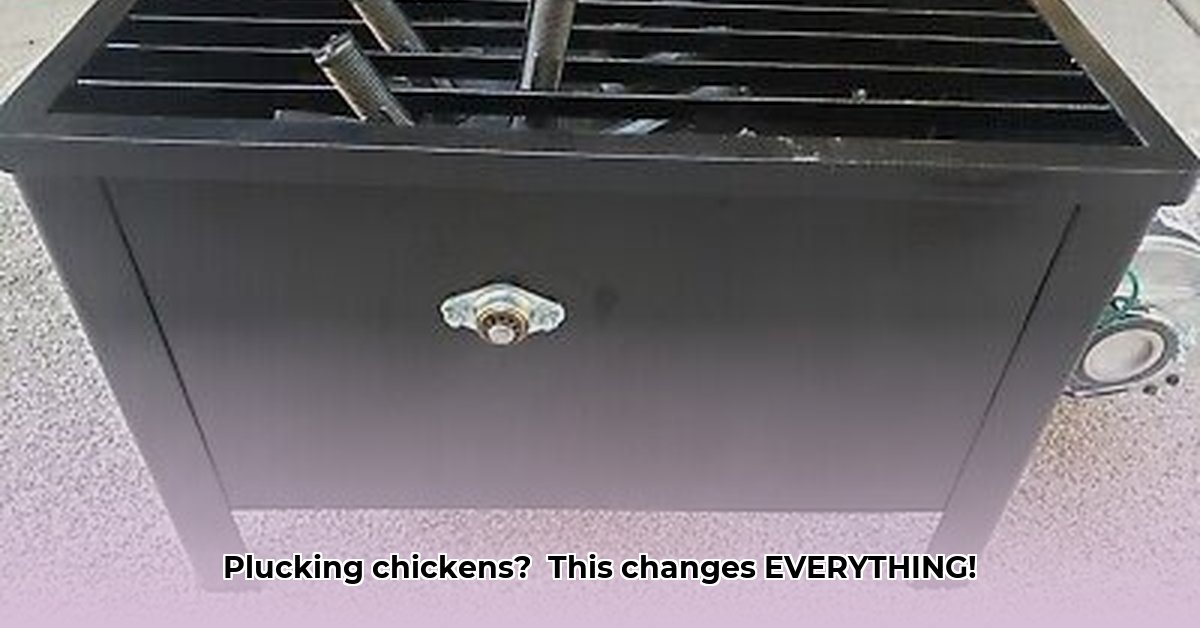
Choosing the Right Chicken Plucker for Your Needs
Investing in a chicken plucker from Tractor Supply can significantly improve the efficiency and profitability of your poultry operation. But with various models available, selecting the right one is crucial. This guide helps you navigate the process, whether you're a seasoned farmer or a homesteader just starting out. A significant time saver for small-scale poultry farming, the right plucker streamlines processing, reducing labor costs and increasing overall farm productivity. For more DIY options, check out these chicken plucker plans.
Factors to Consider When Choosing a Plucker
Several key factors influence your chicken plucker choice:
Flock Size and Processing Frequency: How many chickens do you process, and how often? A small backyard flock (under 50 birds) requires a smaller, less powerful model than a larger-scale operation (100+ birds). Processing frequency (weekly, monthly, seasonally) also impacts plucker size and capacity needs. A larger operation processing birds weekly demands a more robust and higher-capacity model capable of handling significant volume.
Budget and ROI: While a quality plucker represents an upfront investment, the long-term savings in labor costs often ensure a quick return on investment (ROI). Consider the total cost, including purchase price, maintenance, and potential repair costs, against the time and labor saved over the machine's lifespan. The time savings alone can considerably boost your farm's bottom line.
Key Features: Consider crucial features like:
- Materials: Stainless steel construction is ideal for its durability, ease of cleaning, and resistance to rust and wear.
- Motor Power: A powerful motor is essential for efficient plucking, particularly for larger birds or high-processing volumes.
- Ease of Cleaning: A simple design with easily removable parts simplifies cleaning and reduces downtime. Quick and thorough cleaning is crucial for food safety and prevents bacterial growth.
- Safety Features: Look for safety mechanisms such as grounded electrical components and well-shielded moving parts.
Setting Up and Using Your Chicken Plucker: A Step-by-Step Guide
Proper setup and operation are critical for safe and effective plucking. Always consult your plucker's user manual for specific instructions.
Step 1: Assembly: Carefully unpack your plucker and assemble it precisely following the manufacturer's instructions. Thoroughly inspect all parts for damage before proceeding. Double-check all connections to ensure proper functionality.
Step 2: Preparation: Ensure the plucker is properly grounded before connecting it to a suitable power source. Confirm the voltage matches your plucker's requirements to prevent damage.
Step 3: Scalding: Scalding is crucial! Prepare your birds by properly scalding them to loosen feathers. This step significantly improves the efficiency of the plucking process. The correct temperature and time for scalding vary, so reference reliable sources for best practices related to your bird type.
Step 4: Loading: Carefully load the birds into the plucker drum. Avoid overcrowding for optimal plucking results. Refer to your owner's manual for appropriate loading guidelines for your specific model.
Step 5: Operation: Start the plucker at a low speed, gradually increasing it as needed. The optimal speed depends on bird size and plucker model. Monitor closely and make adjustments as necessary to ensure consistent and efficient plucking.
Step 6: Unloading: Once the plucking is complete, carefully remove the birds from the drum. Ensure the plucker is completely off before handling plucked chickens.
Step 7: Safety Precautions: Never reach into the operating drum. Keep children and pets away from the running machine. Always disconnect the power source before cleaning or performing maintenance.
Maintenance and Cleaning: Prolonging the Life of Your Plucker
Regular maintenance is vital for prolonging your plucker's lifespan and ensuring its continued performance.
Cleaning: Immediately after each use, thoroughly clean the entire plucker, including the drum, rubber fingers, and any other components. Remove all feathers and debris; use a food-safe disinfectant to sanitize the equipment, minimizing contamination risks.
Lubrication: Check your owner's manual for lubrication recommendations and instructions. Regular lubrication is crucial to keeping moving parts working smoothly and preventing wear and tear, extending the machine's lifespan.
Storage: Store your plucker in a clean, dry, well-ventilated area, away from moisture and extreme temperatures. This minimizes rust and corrosion and protects the machine from damage.
Troubleshooting Common Problems
Even with proper care, issues can arise. Here are some common problems and their solutions:
- Plucker isn't functioning: Check power supply, connections, and circuit breakers.
- Uneven plucking: Adjust the plucker's speed and assess your scalding process. Insufficient scalding is a common cause of uneven plucking.
- Excessive noise: This may signify motor or bearing wear. If so, consult a professional repair person.
- Rubber finger damage: Regularly inspect and replace worn rubber fingers to maintain efficiency.
Conclusion: Efficient and Sustainable Poultry Processing
Investing in a chicken plucker from Tractor Supply offers significant advantages for small-scale poultry farmers and homesteaders. By following the guidelines outlined in this guide, you can select the appropriate plucker, operate it safely and efficiently, and maintain it properly for long-term performance and a strong return on investment. Remember, prioritizing safety and hygiene is crucial for both efficient operation and the production of high-quality poultry products. Happy plucking!